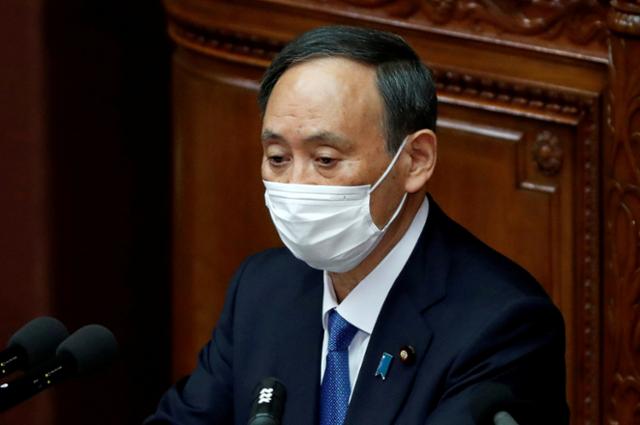
Japanese Prime Minister Yoshihide Suga announced on the 18th that the new coronavirus infection (Corona 19) emergency, which is in effect in some areas of the metropolitan area, such as Tokyo, will be completely lifted by the end of the 21st. The picture shows Prime Minister Suga giving a municipal speech at the regular National Assembly, which opened on January 18th. Tokyo Reuters = Yonhap News
The emergency declaration of the novel coronavirus infection (Corona 19) issued in four areas in the Japanese metropolitan area (Tokyo, Kanagawa, Saitama, and Chiba Prefecture) will be lifted on the 21st. As a result, on January 8th, the issue of emergencies, which began with the metropolitan area and expanded to 11 metropolitan local governments, was extended two times, centering on the metropolitan area, and was resolved in two and a half months.
The Japanese government held a meeting of the Corona 19 Countermeasure Headquarters at the Prime Minister’s residence on the evening of the 18th and made this decision. Prime Minister Yoshihide Suga announced this policy earlier this afternoon at the Steering Committee of the House of Representatives. Even after the declaration is lifted, requests for reduction of business hours for restaurants, etc. will be maintained until the end of this month, but the time will be eased from 8:00 p.m. to 9:00 p.m.
Prime Minister Suga heard a decrease in the use of beds as a reason for the emergency relief. In fact, the rate of use of beds in the four regions has decreased to the level of 25-40%. According to the Asahi Shimbun and others, the officials of the Prime Minister’s residence explained that there was a “fatigue” of the people behind the lifting of the declaration. It is said that it is difficult for the people to keep going out because they are exhausted.
The newspaper reported that the restaurant’s shortened business was also’economically limited’ and expressed an opinion that it could no longer be handled. Mobile telecommunications companies measured the crowds in downtown Tokyo such as Shibuya and Ginza over the weekend, showing an increase of around 30% compared to January.
However, some are concerned about the loose atmosphere caused by the release of the emergency. As the number of new confirmed cases is increasing, experts are talking about’rebound’. The number of new confirmed cases per day, which had been close to 8,000 in early January, has steadily decreased to around 1,000, but has been increasing slightly in recent years. On the 17th, the number of new infections nationwide was 1,535, the highest in one month, and the Tokyo area again surpassed 400.
For this reason, at a meeting of the Ministry of Health, Labor and Welfare Advisory Group on the 17th, Takashi Wakita, head of the National Infectious Disease Research Institute, said, “There was an opinion that a rebound seems to have already begun in urban areas.” Toshio Nakagawa, chairman of the Japanese Medical Association, also held a press conference on the same day, arguing that “even if the declaration is lifted, key measures to prevent the spread of infection should be applied at the same time.”
In the midst of this, Miyagi Prefecture recently announced its own emergency declaration on the same day as the number of infected people increased rapidly. The period is from this day to April 11th. In the downtown area of Sendai City, where restaurants are concentrated, intensive inspections will be conducted from the end of March. In the middle of last month, Miyagi prefecture conducted a “GoTo Eat,” which gives out coupons for eating out, and then the number of infected people surged in Sendai City, and 107 new infected people, the largest in the prefecture on the 16th, came out.
Tokyo= Jinjoo Choi Correspondent [email protected]
News directly edited by the Hankook Ilbo can also be viewed on Naver.

